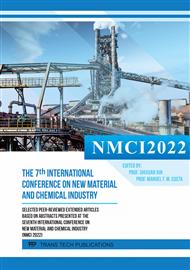[1]
J.G. Song, X.Q. Wang, L. Chen, Preparation and properties of Al-Al2O3 metal ceramics via powder metallurgy methods [J]. J. Ceram. Proc. Res. 19 (2018) 50-53.
Google Scholar
[2]
F. Wang, A.X. Chen, C. Yang, Preparation and characterization of coated alumina/aluminum cermet composite powder via ball milling method [J]. Key Eng. Mater. 861 (2020) 250-255.
DOI: 10.4028/www.scientific.net/kem.861.250
Google Scholar
[3]
Y.G. Joshi, D.R. Zanwar, S. S. Joshi, N. A. Bhave, Experimental investigation of Al2O3 nanosuspension in vapor compression refrigeration system using tetrafluoroethane and isobutane refrigerants [J]. Mater. Tod. 50 (2022) 1804-1813.
DOI: 10.1016/j.matpr.2021.09.209
Google Scholar
[4]
X.F. Zang, S.P. Niu, Z.Q. DENG, Preparation of Al2O3 nanowires on 7YSZ thermal barrier coatings against CMAS corrosion,Trans [J]. Nonf. Meta. Soc. Chin. 29 (2019) 2362-2370.
DOI: 10.1016/s1003-6326(19)65142-3
Google Scholar
[5]
Z.Q. Fan, Y.T. Zhao, Q.Y. Tan, Nanostructured Al2O3-YAG-ZrO2 ternary eutectic components prepared by laser engineered net shaping [J]. Acta Materialia, 170 (2019) 24-37.
DOI: 10.1016/j.actamat.2019.03.020
Google Scholar
[6]
D. Wang, Y.F. Bai, C. Xue, Optimization of sintering parameters for fabrication of Al2O3/TiN/TiC micro-nano-composite ceramic tool material based on microstructure evolution simulation [J]. Ceram. Int. 47 (2021) 5776-5785.
DOI: 10.1016/j.ceramint.2020.10.164
Google Scholar
[7]
G.Murugadoss, R.Thangamuthu, M.R. Kumar, Formamidinium lead iodide perovskite: Structure, shape and optical tuning via hydrothermal method [J]. Mater. Lett. 231 (2018) 16-19.
DOI: 10.1016/j.matlet.2018.08.003
Google Scholar
[8]
A.P. Bayuseno, W.W. Schmahl, Hydrothermal synthesis of struvite and its phase transition: Impacts of pH, heating and subsequent cooling methods [J]. J. Cryst. Growth 498 (2018) 336-345.
DOI: 10.1016/j.jcrysgro.2018.06.026
Google Scholar
[9]
Z.L. Lv, Y. Zheng, H. Zhou, Hydrothermal method-assisted synthesis of self-crosslinked all lignin based hydrogels [J]. Int. J. Biolog. Macrom. 216 (2022) 670-675.
DOI: 10.1016/j.ijbiomac.2022.07.003
Google Scholar
[10]
J. Kim, D. Lee. Synthesis and properties of core-shell metal-ceramic microstructures and their application as heterogeneous catalysts. Chemcat Chem. 2014, 6: 2642-47.
DOI: 10.1002/cctc.201402274
Google Scholar
[11]
M. Veith, H. Carparrotti, V. Huch, Two new metal derivates of the alumosiloxane [Ph2SiO]8 [AlO(OH)]4 : [Ph2SiO]8[AlO2(Na)]4 · 5 [J]. J. Organ. Chem. 692 (2007) 2784-2788.
DOI: 10.1016/j.jorganchem.2007.02.049
Google Scholar



